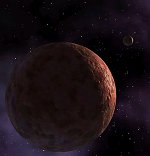Lack of moon orbiting Sedna puzzles astronomers
Posted: Wed, Apr 14, 2004, 11:47 PM ET (0347 GMT)
 Hubble observations of the newly-discovered planetoid Sedna have failed to turn up any evidence of a moon, leaving scientists to wonder why the distant object rotates so slowly. Images of Sedna, taken by Hubble shortly after its discovery was announced last month, failed to discover a moon that astronomers had thought was orbiting the large planetoid. Astronomers had thought that Sedna had a moon based on evidence that the planetoid was rotating so slowly, with an estimated period of about 20 or 40 days, far slower than any other solar system object other than Mercury and Venus. That slow rotation could be explained if Sedna was tidally locked with a moon, but is difficult to explain otherwise. Astronomers did note that there is a small chance that any moon was hidden from Hubble's view by being directly in front of Sedna or directly behind it. Sedna, officially still known 2003 VB12, is the most distant solar system body yet known, currently about 13 billion kilometers from the Earth. It is believed to be as large as 1600 km in diameter, about three-quarters the size of Pluto.
Hubble observations of the newly-discovered planetoid Sedna have failed to turn up any evidence of a moon, leaving scientists to wonder why the distant object rotates so slowly. Images of Sedna, taken by Hubble shortly after its discovery was announced last month, failed to discover a moon that astronomers had thought was orbiting the large planetoid. Astronomers had thought that Sedna had a moon based on evidence that the planetoid was rotating so slowly, with an estimated period of about 20 or 40 days, far slower than any other solar system object other than Mercury and Venus. That slow rotation could be explained if Sedna was tidally locked with a moon, but is difficult to explain otherwise. Astronomers did note that there is a small chance that any moon was hidden from Hubble's view by being directly in front of Sedna or directly behind it. Sedna, officially still known 2003 VB12, is the most distant solar system body yet known, currently about 13 billion kilometers from the Earth. It is believed to be as large as 1600 km in diameter, about three-quarters the size of Pluto.
 Hubble observations of the newly-discovered planetoid Sedna have failed to turn up any evidence of a moon, leaving scientists to wonder why the distant object rotates so slowly. Images of Sedna, taken by Hubble shortly after its discovery was announced last month, failed to discover a moon that astronomers had thought was orbiting the large planetoid. Astronomers had thought that Sedna had a moon based on evidence that the planetoid was rotating so slowly, with an estimated period of about 20 or 40 days, far slower than any other solar system object other than Mercury and Venus. That slow rotation could be explained if Sedna was tidally locked with a moon, but is difficult to explain otherwise. Astronomers did note that there is a small chance that any moon was hidden from Hubble's view by being directly in front of Sedna or directly behind it. Sedna, officially still known 2003 VB12, is the most distant solar system body yet known, currently about 13 billion kilometers from the Earth. It is believed to be as large as 1600 km in diameter, about three-quarters the size of Pluto.
Hubble observations of the newly-discovered planetoid Sedna have failed to turn up any evidence of a moon, leaving scientists to wonder why the distant object rotates so slowly. Images of Sedna, taken by Hubble shortly after its discovery was announced last month, failed to discover a moon that astronomers had thought was orbiting the large planetoid. Astronomers had thought that Sedna had a moon based on evidence that the planetoid was rotating so slowly, with an estimated period of about 20 or 40 days, far slower than any other solar system object other than Mercury and Venus. That slow rotation could be explained if Sedna was tidally locked with a moon, but is difficult to explain otherwise. Astronomers did note that there is a small chance that any moon was hidden from Hubble's view by being directly in front of Sedna or directly behind it. Sedna, officially still known 2003 VB12, is the most distant solar system body yet known, currently about 13 billion kilometers from the Earth. It is believed to be as large as 1600 km in diameter, about three-quarters the size of Pluto.
Related Links:
| <<previous article | next article>> |
|
news in brief
|
|
FAA restricts hours for commercial launches during shutdown
Posted: Sun, Nov 9 9:05 AM ET (1405 GMT) China postpones Shenzhou-20 return on orbital debris concerns
Posted: Sun, Nov 9 8:58 AM ET (1358 GMT) |
|
news links
|
|
Wednesday, November 12
Does quantum gravity exist? A new experiment has deepened the mystery
SPACE.com — 5:50 am ET (1050 GMT) Giving Gemini its due: 'Apollo 13' author Jeffrey Kluger honors 'forgotten' NASA program with new book
SPACE.com — 5:48 am ET (1048 GMT) Sun unleashes strongest solar flare of 2025, sparking radio blackouts across Africa and Europe
SPACE.com — 5:48 am ET (1048 GMT) Mars orbiter spies 'barcode' aftermath of rare Red Planet avalanche caused by meteoroid impact
SPACE.com — 5:47 am ET (1047 GMT) Astronomers discover the famous Pleiades star cluster could be 20 times bigger than we thought
SPACE.com — 5:46 am ET (1046 GMT) |